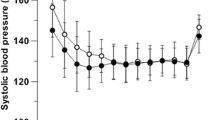Summary
Renal function is responsible for homoestasis in the organism. Renal impairment causes life-threatening damage. Intraoperative bleeding, hypotension, stress and toxins (endogenous, exogenous) during surgery could impair renal function and cause postoperative renal damage. Mortality after coronary graft surgery is usually between 1–2% and acute postoperative renal failure (ARF) increases mortality up to 60–75%. High sympathetic tone and extracorporal circulation under coronary graft surgery are important factors influencing postoperative renal failure. Experimental and clinical studies have shown a reduction of sympathetic tone and catecholamine concentration by α2-agonists. Renal perfusion and glomerular filtration is improved. This could prevent renal damage in patients undergoing coronary graft surgery and extracorporal circulation.
Zusammenfassung
Die Nierenfunktion ist verantwortlich für die Homöostase im Organismus, Einschränkungen können lebenswichtige Funktionen beeinträchtigen. Im Rahmen operativer Eingriffe beeinflussen verschiedene Faktoren die Nierenfunktion (Hypotonie, Blutung, endogene und exogene Toxine, Stress) und können eine postoperative Nierenfunktionseinschränkung verursachen. Das akute postoperative Nierenversagen (ANV) beeinflusst auch bei kardiochirurgischen Patienten entscheidend die Mortalität, die normalerweise bei 1–2% liegt und durch das ANV bis auf 60–75% ansteigen kann. Der erhöhte Sympathikotonus unter operativen Bedingungen und die speziell bei kardiochirurgischen Eingriffen notwendige extrakorporale Zirkulation werden als entscheidende Ursachen für die postoperative Nierenfunktionseinschränkung angesehen. In experimentellen und klinischen Studien wurde nachgewiesen, dass α2-Adrenozeptoragonisten den Sympathikotonus senken und Plasmakatecholaminspiegel vermindern. Dieses führt an der Niere zu einer verbesserten renalen Perfusion und glomerulären Filtration. Bei Patienten unter koronarer Bypasschirurgie mit extrakorporaler Zirkulation kann dadurch eine Verschlechterung der Nierenfunktion verhindert werden.
Similar content being viewed by others
Literatur
Aggarwal A, Esler MD, Morris MJ, Lambert G, Kaye DM (2003) Regional sympathetic effects of low-dose clonidine in heart failure. Hypertension 41(3):553–557
Bergman AS, Odar-Cederlof I, Westman L, Bjellerup P, Hoglund P, Ohqvist G (2002) Diltiazem infusion for renal protection in cardiac surgical patients with preexisting renal dysfunction. J of Cardiothoracic and Vascular Anesthesia 16(3):294–299
Browner WS, Mangano DT (1992) Inhospital and long-term mortality in male veterans following noncardiac surgery. The study of perioperative ischemia research group. JAMA 8:228–232
Carcoana OV, Mathew JP, Davis E, Byrne DW, Hayslett JP, Hines RL et al (2003) Mannitol and dopamine in patients undergoing cardiopulmonary bypass: a randomized clinical trial. Anesthesia and Analgesia 97:1222–1229
O'Connor JP, Ramsay JG, Wynands JE et al (1993) Anesthesia for myocardial revascularisation. In: Kaplan J (ed) Cardiac Anesthesia. WB Saunders, Philadelphia, pp 587–628
Frost L, Lund O, Smith Pederson R et al (1992) Prognosis and risk factors in acute dialysis-requiring renal failure after open heart surgery. Ugeskr Laeger 154:2481–2485
Gailiunas P Jr, Chawla R, Lazarus JM et al (1980) Acute renal failure following cardiac operations. J Thorac Cardiovasc Surg 79:241–243
Guyton AC (1991) Blood pressure control-special role of the kidneys and body fluids. Science (United States) 252(5014):1813–1816
Higgins TL (1994) Postoperative complications and ICU. In: Estafanous FG, Barash PG, Reves JG (eds) Cardiac Anesthesia. JB Lippincott, Philadelphia, pp 373–402
Hilbermann L, Derby GC, Spencer RJ et al (1980) Sequential pathophysiological changes characterizing the progression from renal dysfunction to acute renal failure following cardiac operations. J Thorac Cardiovasc Surg 79:241–243
Kellen M, Aronson S, Roizen MF, Barnard J, Thisted RA (1994) Predictive and diagnostic tests of renal failure: a review. Anesthesia and Analgesia 78:134–142
Kreutz R, Kruse HJ, Overlack A, Stumpe KO, Kolloch RE (1996) Effects of sympathetic inhibition on blood pressure and renal responses to central hypervolaemia in normal humans. Acta Physiologica Scandinavia 156(1):1–7
Kulka PJ, Tryba M, Zenz M (1996) Preoperative alpha sub 2-adrenergic receptor agonists prevent the detoriation of renal function after cardiac surgery: Results of a randomized, controlled trial. Crit Care Med 24(6):947–952
Lassnigg A, Donner E, Grubhofer G, Presterl E, Drubl W, Hiesmayr M (2000) Lack of renoprotective effects of dopamine and furosemide during cardiac surgery. Journal of American Society of Nephrology 11:97–104
Lehot JJ, Villard J, Piriz H et al (1992) Hemodynamic and hormonal responses to hypothermic and normothermic cardiopulmonary bypass. J Cardiothorac Vasc Anesth 6:132–139
Lenaerts A, Codden T, Van Cauter J, Meunier JC, Henry JP, Ligny G (2002) Interest of the association clonidine-spironolactone in cirrhotic patients with ascites and activation of sympathetic nervous system. Acta Gastroenterologica Belgica 65(1):1–5
Liasalmi M, Koivusalo AM, Valta P, Tikkanen I, Lindgren L (2001) Clonidine provides opioid-sparing effect, stable hemodynamics and renal integritiy during laparoscopic cholecystectomy. Surgical Endoskopy 15(11):1331–1335
Liepert DJ, Townsend GE (1990) Improved hemodynamic and renal function with clonidine in coronary artery bypass grafting. Anesth Analg 70:S240 (Abstract)
Mazzarella V, Gallucci T, Tozzo C et al (1992) Renal function in patients undergoing cardiopulmonary bypass operations. J Thorac Cardiovasc Surg 104:1625–1627
Murkin JM, Martzke JS (1993) Central nervous system dysfunction after cardiopulmonary bypass. In: Kaplan JA (ed) Cardiac Anesthesia. WB Saunders, Philadelphia London Toronto Montreal Sydney Tokyo, pp 1225–1239
Taylor KM (1988) Vasopressor release and multiple organ failure in cardiac surgery. Perfusion 3:1–16Taylor KM (1988) Vasopressor release and multiple organ failure in cardiac surgery. Perfusion 3:1–16
Woo EB, Tang AT, el-Gamel A, Keevil B, Greenhalgh D, Patrick M et al (2002) Dopamine therapy for patients at risk of renal dysfunction following cardiac surgery: science or fiction? European Journal of Cardio-thoracic Surgery 22:106–111
Zacharias M, Gilmore ICS, Herbison GP, Sivalingam P, Walker RJ (2006) Interventions for protecting renal function in the perioperative period. The Cochrane Database of Systematic Reviews, Issue 2
Author information
Authors and Affiliations
Corresponding author
Rights and permissions
About this article
Cite this article
Wegermann, P., Tryba, M. & Kulka, P.J. Renale Effekte von Clonidin bei kardiochirurgischen Patienten. Clin Res Cardiol Suppl 2 (Suppl 1), S85–S90 (2007). https://doi.org/10.1007/s11789-006-0044-7
Issue Date:
DOI: https://doi.org/10.1007/s11789-006-0044-7
Key words
- Sympathetic tone
- α2-adrenoceptor
- α2-adrenoceptor agonists
- coronary graft surgery
- renal function
- renal damage




